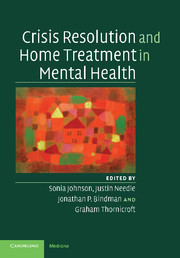Book contents
- Frontmatter
- Contents
- List of contributors
- Foreword
- Acknowledgements
- Section 1 Introduction and concepts
- Section 2 The evidence
- Section 3 Current practice
- 6 Crisis resolution teams: rationale and core model
- 7 The crisis resolution team within the community service system
- 8 Assessment of crises
- 9 Assessment and management of risk
- 10 Symptom management
- 11 Practical psychosocial interventions
- 12 Working with families and social networks
- 13 Strategies for promoting engagement and treatment adherence
- 14 Mixed blessings: service user experience of crisis teams
- 15 Early discharge and joint working between crisis teams and hospital services
- 16 Working with repeat users of crisis resolution services
- 17 Responding to diversity in home treatment
- 18 Coercion and compulsion in crisis resolution teams
- Section 4 Variations and enhancements
- Section 5 Developing a local service
- Index
- References
17 - Responding to diversity in home treatment
from Section 3 - Current practice
Published online by Cambridge University Press: 13 August 2009
- Frontmatter
- Contents
- List of contributors
- Foreword
- Acknowledgements
- Section 1 Introduction and concepts
- Section 2 The evidence
- Section 3 Current practice
- 6 Crisis resolution teams: rationale and core model
- 7 The crisis resolution team within the community service system
- 8 Assessment of crises
- 9 Assessment and management of risk
- 10 Symptom management
- 11 Practical psychosocial interventions
- 12 Working with families and social networks
- 13 Strategies for promoting engagement and treatment adherence
- 14 Mixed blessings: service user experience of crisis teams
- 15 Early discharge and joint working between crisis teams and hospital services
- 16 Working with repeat users of crisis resolution services
- 17 Responding to diversity in home treatment
- 18 Coercion and compulsion in crisis resolution teams
- Section 4 Variations and enhancements
- Section 5 Developing a local service
- Index
- References
Summary
When patients are treated in their own homes rather than in an institutional setting, their social circumstances and identities are necessarily much more visible and salient. This offers very valuable opportunities to assess social determinants of the crises, to deliver interventions that are appropriate to clients' social and cultural needs and to engage the key members of their social networks in the management of their mental health problems. Considerable challenges accompany these opportunities. Home treatment clinicians cannot avoid having their own values and preconceptions challenged by the great range of ways of living and thinking that they will find among patients and their social networks, and adapting interventions so that they are appropriate to the full range of clients' values and social circumstances requires considerable imagination and sensitivity to diversity. In this chapter, we will explore the ways in which crisis resolution teams (CRTs) can try to respond effectively to clients' diverse needs. Our main focus will be on responding to ethnic, religious and cultural variations, but in the latter part of the chapter, we will also address gender-specific needs and home treatment for gay men and lesbians.
Ethnic diversity: background and current service provision
Migrants from Asia, Africa, eastern Europe and the Caribbean Islands permanently reside as ethnic minorities in many Western countries. Numbers both of asylum seekers and economic migrants have substantially increased, driven by wars and global political upheavals and by economic disparities.
- Type
- Chapter
- Information
- Crisis Resolution and Home Treatment in Mental Health , pp. 205 - 222Publisher: Cambridge University PressPrint publication year: 2008
References
- 1
- Cited by



